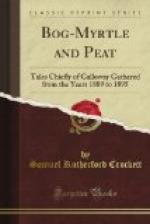So had I gone many a time in mine own country, and so I meant to lead my pupil now. Henry Fenwick rose joyously at the thought. Madame had made his service a little hard, and, what is worse, a little monotonous. He was but a boy, and needed not, she thought, the binding distractions which usually accompany such allegiances.
CHAPTER II
THE WORD OF THE LITTLE PEOPLE
Betimes in the morning we were afoot—long before Madame was awake; and having committed our heavier luggage to the care of our Swiss landlord, we set each a knapsack on our backs, and with light foot passed through the market-place among the bright and chattering throng of Italian folk, whose greetings of “Buone feste, buon principio, e buona fine” told of the birth of another day of joy for them under the blue of their sky.
Before we were clear of the town, Henry turned, and as he glanced at the green valanced windows of the Hotel Averso he drew a long breath which was not quite a sigh. And this was all his farewell to the allegiance of half a score of weeks. For my part, I was not easy till we swung out of sight along the dusty road, and had skirted the first two or three miles of old wall and vineyard terrace, where the lizards were already flashing and darting in the sun.
But indeed it takes much to chain a young man’s fancy, when the road of life runs enticingly before him, dappled with laurel and carpeted with primrose.
It was our vagabond year, and, as I had foretold, a fair maid stood at every door, smiling at us and leading us on. We did not keep long by the dusty road. Presently we turned up byways, over which the prickly-pear and red valerian broke in profuse and unprecise beauty—fleshy-leaved creepers, too, as of a house-leek turned passion-flower, over-crowned all with scarlet blotches of cunningly placed colour.
We wandered into woodland paths and across fields. A peasant or small farmer ran out to stay us. Something was forbidden, it appeared. We were trampling his artichokes or other precious crop. We understood him not over well, nor indeed tried to. But a touchingly insignificant piece of silver induced him to think more kindly of our error, and he showed us a sweet path, by the side of which a brook tinkled down from the cliffs above. It led us into another scene—and, I am of opinion, upon another man’s property. For at the door of a low, square-roofed house stood a man with his hands clasped behind him. He frowned, for he had seen his neighbour of the itching palm lead us to his gate and there leave us. And of the silver that lay within that palm he had not partaken.
The sun was broad and high. Here were flats of hay, greyish-green, blue in parts—but with none of that moist and emerald velvet which would have flashed upon the burnside meadows at home. Again by the water we brushed against the asters, which had no business to be growing here in the spring. Among the young wheat the poppies were flaming—red-coat officers of the Sower of Tares, with flaunting feather leading on to the inquisition of fires, when the reapers edge their keen sickles and fall-to, and the tares are separated from the wheat.




